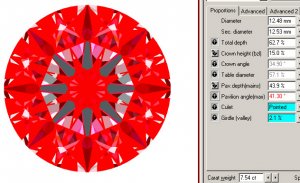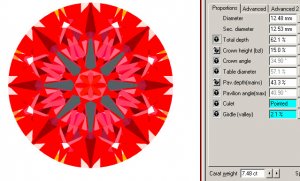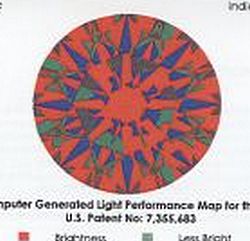FB.
Brilliant_Rock
- Joined
- Jun 29, 2009
- Messages
- 764
This seems to be one of the most common sets of proportions - even for stones which aren''t desperately trying to cling to a magic carat number.
A typical overall set of proportions for a GIA-Ex would be something like:
Table 57%
Crown 15% (35'')
Star: 50%
Girdle: medium
Pavilion: 44% (41.2'')
Lower half: 80%
Such stones score about 4 on the HCA; good or very good in most categories.
I know that many PS-ers dislike the steep-deep stones (with reduced light return under the table), but someone must be buying them.
Having seen (and owning), for myself, a number of these stones, you have to get the light and position fairly consistent (from straight above) to barely be able to notice the darker table - and the darker table is often masked by the appearance of the black arrows, if the symmetry is excellent.
But is the fear of a slightly darker table generally worse than the reality ? - since most diamonds get viewed from avariety of angles, whereas the HCA seems to have been designed for evaluating the directly-overhead view (correct me if I''m wrong).
Regards,
A typical overall set of proportions for a GIA-Ex would be something like:
Table 57%
Crown 15% (35'')
Star: 50%
Girdle: medium
Pavilion: 44% (41.2'')
Lower half: 80%
Such stones score about 4 on the HCA; good or very good in most categories.
I know that many PS-ers dislike the steep-deep stones (with reduced light return under the table), but someone must be buying them.
Having seen (and owning), for myself, a number of these stones, you have to get the light and position fairly consistent (from straight above) to barely be able to notice the darker table - and the darker table is often masked by the appearance of the black arrows, if the symmetry is excellent.
But is the fear of a slightly darker table generally worse than the reality ? - since most diamonds get viewed from avariety of angles, whereas the HCA seems to have been designed for evaluating the directly-overhead view (correct me if I''m wrong).
Regards,








300x240.png)